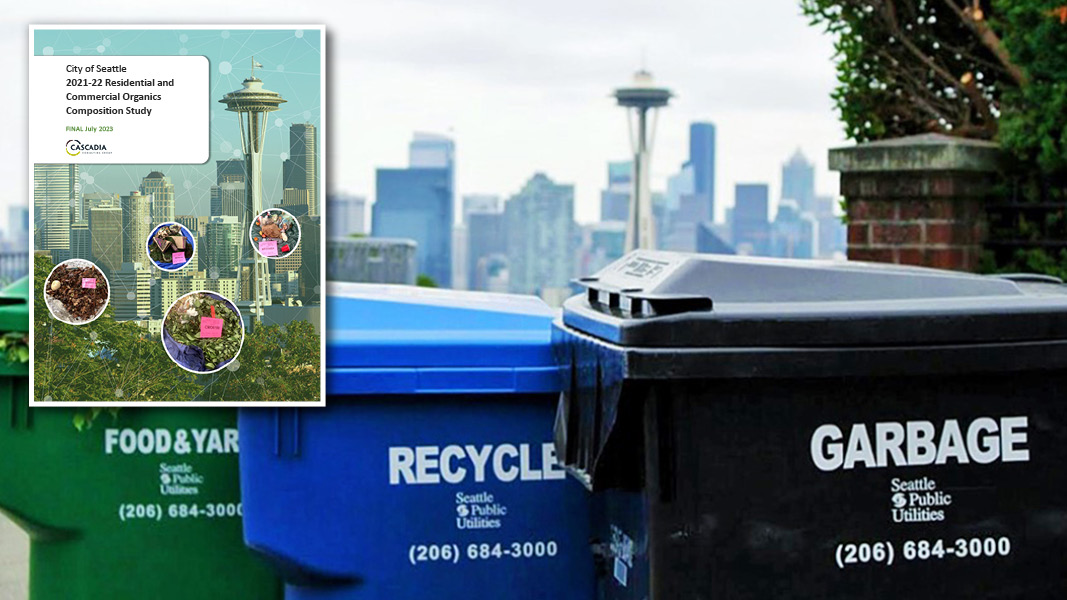Top: Background photo courtesy of Seattle Public Utilities
In 2021–22, Cascadia Consulting Group (Cascadia) was contracted by Seattle (WA) Public Utilities (SPU) to carry out six seasonal sampling events. The findings are in a report released in July 2023, “City of Seattle: 2021-22 Residential and Commercial Organics Composition Study.” Over the course of the six sampling events, field teams collected 615 samples of material set out for SPU-contracted organics collection. These samples included 202 from single-family homes, 210 from multifamily properties, and 203 from commercial businesses. Single-family samples were collected from organics collection trucks, while multifamily and commercial samples were collected directly from customer carts. The residential study began in September 2021, and the commercial study was delayed until January 2022 to give businesses more time to recover from the COVID-19 pandemic. Cascadia hand-sorted these samples into 26 specific material types that were grouped into four broad material classes and three recoverability classes. Its analysis further breaks down the compostable recoverability class into three groups: yard trimmings, food waste, and other compostables, such as food-soiled paper and approved compostable packaging.
During the residential organics study period (September 2021 to August 2022), haulers WM and Recology collected 85,935 tons of material from single-family homes through SPU-contracted cart organics collection service and 3,986 tons from multifamily properties with SPU-contracted cart organics collection service. During the commercial study period (January to December 2022), haulers collected 4,893 tons from commercial businesses through SPU-contracted cart organics collection service. In 2022, an estimated 92% of commercial organic (53,778 tons) material was collected through private contracts (vs. SPU-contracted collection) between businesses and haulers, which are not reflected in the study results. For all sectors combined, 97.9% of materials collected through the SPU-contracted organics stream were compostable. The largest share was yard trimmings (69.1%) followed by food waste (20.3%). Findings for the three sectors are:
- Single-family: 98.3% (84,455 tons) were compostable. The largest share was yard trimmings (74.7%; 64,207 tons), followed by food waste (15.6%; 13,374 tons).
- Multifamily: 93.2% (3,715 tons) were compostable. The largest share was food waste (56.6%; 2,255 tons), followed by yard trimmings (22.6%; 899 tons).
- Commercial: 94.4% (4,618 tons) were compostable. The largest share was food waste (73.1%; 3,575 tons), followed by other accepted compostable items (13.8%; 677 tons). Other accepted compostable items include uncoated paper and certified compostable paper and plastic items.
The 2021–22 organics study also estimated how much of the organics stream included edible food, such as whole fruits and meat, and non-edible food, such as fruit peels and eggshells. For all sectors combined, 20.3% was food, which included edible food (7.8%) and non-edible food (12.5%).
Contaminants, which include non-compostable material types and potentially compostable paper and plastic, were 2.1% of collected materials by weight for all sectors combined. The most common contaminant material types were potentially compostable paper (0.6%), other non-recoverable waste (0.3%), and pet waste (0.2%). Other non-recoverable waste includes materials not otherwise categorized such as non-recyclable glass, hazardous waste, and diapers. Contaminants broken out by sector are:
- Single-family organics: 1.7% (1,480 tons); the most common material types were potentially compostable paper (0.6%), other non-recoverable waste (0.2%), and recyclable plastic containers (0.2%).
- Multifamily organics: 6.8% (270 tons); the most common material types were other non-recoverable waste (1.6%), pet waste (1.4%), and potentially compostable paper (1.3%).
- Commercial organics: 5.6% (276 tons); the most common material types were potentially compostable paper (1.1%), pet waste (0.8%), and non-compostable film (0.8%).
The 21-2022 SPU Organics Composition Study can be downloaded at this link.













